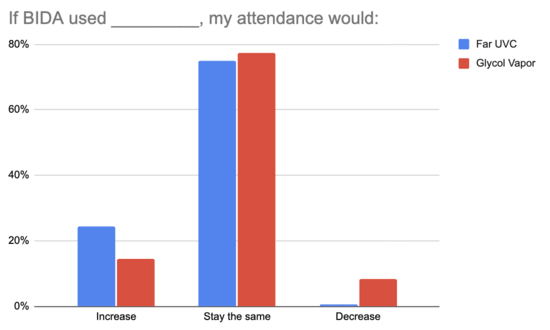Published on October 14, 2025 1:00 AM GMT
A dance organization I help run, BIDA, recently ran a survey.Several of the questions asked how folks felt about usingfarUVC and glycol vapors to reduce risk from COVID, flu, and otherairborne pathogens. There were 208 respondents, which is pretty good!
When asked how their attendance would change if BIDA used theseinterventions, the response was:
| Unchanged | Increased | Decreased | |
|---|---|---|---|
| Far UVC | 75% (153) | 25% (50) | 1% (1) |
| Glycol Vapor | 77% (156) | 14% (29) | 8% (17) |
There were also free response answers, which you can read in the fullwriteup, onthe BIDA blog. Summarizing them:
On far UVC, the person who said their attendance would decreasedidn't give a comment giving more detail. The other comments werebroadly supportive (~54) people, followed by neutral (~18 people),uncertain and wanting more information (~11 people), and skepticalthat the lamps would actually reduce infections (~9 people).
On glycol vapors, the most common response was generallypositive about more ways to reduce infection (~37), followed bywanting more information (~19), not caring (~17), strongly dislikingthe idea (~14), and more complex views (~10).
These results show a community that's strongly in favor of far UVC,which makes a lot of sense to me. The efficacy of UVC is proportionalto sight lines, since it's beams of light, so it's a great fit for abig room with a tall ceiling. We'd need four lamps, which would cost$2,000. This is a meaningfulamount of money, but with a total of 5,400 admissions at our dances inthe 2024-2025 season and the lamps lasting at least 5y it's~3¢/person-hour. For comparison, we spend about ten times thatmuch per person-hour to provide people with disposable N95s.
The situation with glycol vapors, however, is much less clear. The evidenceon safety is if anything stronger than on far UVC, and it'sincredibly cheap (a $50 gallon of Triethylene Glycol is good for about2y of dances). But we also have a significant number ofpeople who don't like the idea (8% saying they'd attend less; ~14negative comments out of 97). Reading through the comments I thinksome objections would turn out not to be an issue once people hadexperience with glycol vapor:
"I don't know much about them, but the CDC says they can irritateeyes and lungs": the level in the air is very low, and no one reportedirritation at the trial dance.
"I have a sensitive nose and an aversion, sometimes reaction, tostrong scents, especially chemical ones. I am deeply grateful for thefragrance free policy and am worried that this may adversely affect myexperience and ability to attend and that of those similarlysituated": Similarly, no one reported being able to smell the vapor atthe trial dance. But BIDA also doesn't prohibitfragrances, and it's common for dancers (especially newer dancers)to wear scents, so I'm a bit confused about their reference to a'fragrance free policy'.
Other objections, however, are from a perspective where experiencewouldn't be relevant:
"I absolutely would not attend any event that had this in theair."
"I'm not comfortable with chemicals being deliberately pumpedinto the air by a DIY project. If there is a commercial system on themarket using this technology, that would change my opinion."
All this has me feeling like I shouldn't push for us to deploy glycolvapors now, and the key thing is getting a commercial system on themarket to address concerns. But then I go back and read the commentsof people who are really positive on them:
"It would GREATLY improve my safety, comfort, and enjoyment!!! Ihope other dances can also take these same precautions! Thank you fordoing this work. (I LOVE SCIENCE when it's used for good. Thank youfor this work!)"
"I would be more comfortable and feel safer, to the point whereI might be okay with dancing unmasked."
"Also strongly in favor, for the same reasons. Let's do both!"
"Increase safety comfort and enjoyment so so so much!!!"
Overall I'm really torn on glycol vapors: the community is, onbalance, in favor of them, and I think the evidence is reallypositive. On the other hand I also respect people having a high barfor evidence for things you breathe in. The board hasn't met to talkabout this yet, and I'm not sure which way I want to push. Thoughts?
Discuss


